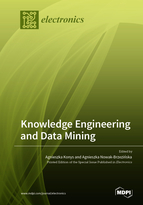Knowledge Engineering and Data Mining
A special issue of Electronics (ISSN 2079-9292). This special issue belongs to the section "Computer Science & Engineering".
Deadline for manuscript submissions: closed (30 November 2022) | Viewed by 38431
Special Issue Editors
Interests: ontology; knowledge representation; semantic web technologies; OWL; RDF; knowledge engineering; knowledge bases; knowledge management; reasoning; information extraction; ontology learning; sustainability; sustainability assessment; ontology evaluation
Special Issues, Collections and Topics in MDPI journals
Interests: knowledge representation and reasoning; rule-based knowledge bases; outliers mining; expert systems; decision support systems; information retrieval systems
Special Issues, Collections and Topics in MDPI journals
Special Issue Information
Dear Colleagues,
Extracting knowledge from data is a fundamental process in creating intelligent information retrieval systems, decision support, and knowledge management. Among the welcome topics of work, we seek research on data mining methods, multidimensional data analysis, supervised and unsupervised learning methods, methods of knowledge base management, language ontologies, ontology learning, and others. We encourage you to present new algorithms and work on practical solutions, i.e., applications/systems presenting the actually created applications of the proposed research achievements.
The Special Issue covers the entire knowledge engineering pipeline: From data acquisition and data mining to knowledge extraction and exploitation. For this reason, we have conceived this Special Issue, whose purpose is to gather the many researchers operating in the field to contribute to a collective effort in understanding the trends and future questions in the field of knowledge engineering and data mining. Topics include, but are not limited to:
- knowledge acquisition and engineering;
- data mining methods;
- big knowledge analytics;
- data mining, knowledge discovery, and machine learning;
- knowledge modeling and processing;
- knowledge acquisition and engineering;
- query and natural language processing;
- data and information modeling;
- data and information semantics;
- data intensive applications;
- knowledge representation and reasoning;
- decision support systems;
- rules mining;
- outliers mining;
- semantic web data and linked data;
- ontologies and controlled vocabularies;
- data acquisition;
- multidimensional data analysis;
- supervised and unsupervised learning methods;
- parallel processing and modeling;
- languages based on parallel programming and data mining.
Dr. Agnieszka Konys
Prof. Dr. Agnieszka Nowak-Brzezińska
Guest Editors
Manuscript Submission Information
Manuscripts should be submitted online at www.mdpi.com by registering and logging in to this website. Once you are registered, click here to go to the submission form. Manuscripts can be submitted until the deadline. All submissions that pass pre-check are peer-reviewed. Accepted papers will be published continuously in the journal (as soon as accepted) and will be listed together on the special issue website. Research articles, review articles as well as short communications are invited. For planned papers, a title and short abstract (about 100 words) can be sent to the Editorial Office for announcement on this website.
Submitted manuscripts should not have been published previously, nor be under consideration for publication elsewhere (except conference proceedings papers). All manuscripts are thoroughly refereed through a single-blind peer-review process. A guide for authors and other relevant information for submission of manuscripts is available on the Instructions for Authors page. Electronics is an international peer-reviewed open access semimonthly journal published by MDPI.
Please visit the Instructions for Authors page before submitting a manuscript. The Article Processing Charge (APC) for publication in this open access journal is 2400 CHF (Swiss Francs). Submitted papers should be well formatted and use good English. Authors may use MDPI's English editing service prior to publication or during author revisions.
Keywords
- knowledge engineering
- knowledge representation and reasoning
- decision support systems
- outliers mining
- data mining
- multidimensional data analysis
- supervised and unsupervised learning methods
- ontology
- knowledge-based systems
- ontology learning
- methods of knowledge base management
- parallel processing and modeling
- languages based on parallel programming and data mining







